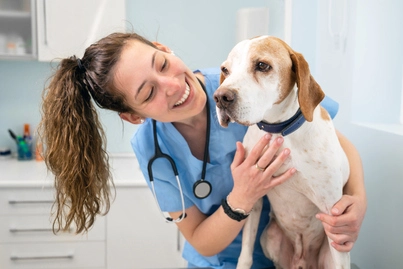Anyone who’s ever stepped on a piece of glass knows the pain and frustration of a cut on the sole of your foot.
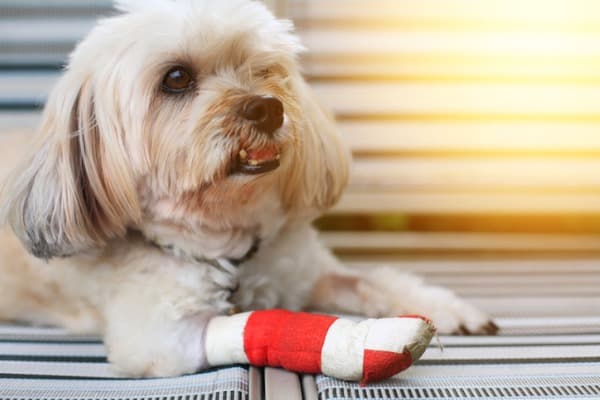
Even if the cut isn’t severe, it makes walking a tricky task.
Our dogs typically go barefoot every day – putting them at risk of stepping on sharp objects.
Dog feet are tough, durable, and designed to take more of a beating than our own.
However:
Those leathery paw pads aren’t indestructible.
If you have a dog paw cut between the toes situation on your hands, and you’re worried about what to do, there are some things to take into account before deciding how to act.
Is it deep?
Is it bleeding?
Is there a foreign object lodged in your dog’s paw?
Contact a vet?
Alternatively, you can have a quick chat with a vet online now, which is both a cost and time savings.
Connect with a verified veterinarian in minutes. No waiting for appointments or office hours. No high fees. Your pet's health made convenient and worry-free.
In this article, we’ll cover some common paw injury scenarios, how to handle them, and when to let the vet take over.
What to Do When the Cut is Fresh
Dogs have their ways of letting others know when they’ve hurt themselves. Many dogs will cry out upon stepping on something sharp.
Even if you didn’t notice your dog voicing their displeasure, a limp, licking at a paw, and tracking blood are tell-tale signs that they’ve injured their foot.
So how to treat a cut on a dog’s paw?
1. Take a Look at the Injury
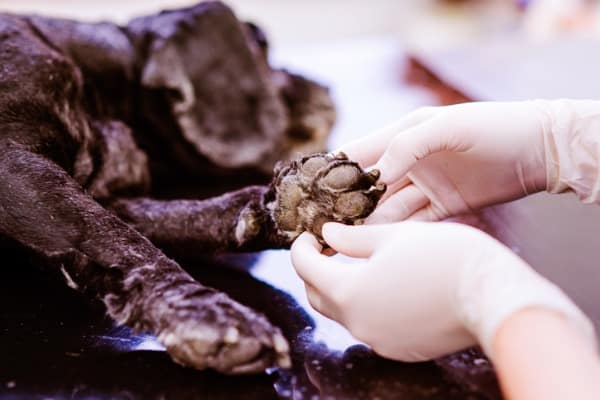
The first thing you need to do is feel comfortable assessing the wound.
This depends entirely on the temperament of your dog and your relationship with them.
Some dogs will lash out instinctively or become very tense when they’re hurt.
Others are relaxed enough that they’ll allow their humans to assist them without fuss.
You know best how well your dog will react.
If you feel like your dog is likely to snap at you, one solution is to put a soft muzzle or Elizabethan collar on them while you inspect the wound.
Even in extremely docile canines:
This task sometimes can take two people – one to hold the dog still and keep them calm, and one to tend to the wound.
Helpful hint:
Both parties should speak to the dog in soothing tones.
Pet them or offer treats as a distraction, and praise them for their cooperation.
It’s a stressful and scary situation to be cut, and your dog will appreciate the moral support.
There are a few things to look for when you inspect the paw: bleeding, foreign objects lodged in the paw pad or between the toes, or other debris like dirt or grass.
If your dog cut the webbing between their toes, be sure not to spread their toes apart too much – it can open the wound even more.
A vet should treat severe bleeding or deeply embedded objects.
What counts as severe bleeding?
In general:
Any bleeding which you cannot get under control within five to ten minutes constitutes an emergency that needs a vet’s attention.
2. Clean the Area
If there is active but not severe bleeding or little to no bleeding, the next step is to wash the wound.
Pouring cool water over the paw is the quickest and easiest method for washing blood, dirt, dust, grass, and small objects away.
Once you have a better view of things, look again at the wound.
You’re searching for small pieces of debris or sharp objects embedded in the paw pad.
Connect with a verified veterinarian in minutes. No waiting for appointments or office hours. No high fees. Your pet's health made convenient and worry-free.
3. Remove Foreign Objects
We only recommend removing small, sharp objects which are not deep in your dog’s paw.
If the foreign object is large or stuck deep in the paw or between the toes, you could do more harm than good by trying to pull it out yourself.
In these cases:
It’s better to let the vet handle it. If your dog is cut between toes, it can also be difficult to remove any lodged sharp objects safely.
What are some things that are generally safe to remove at home?
Small shards of plastic, glass, or metal, splinters, tacks, or small sewing pins are usually safe to pull out.
Things like large chunks of glass, fish hooks, or nails are something you’d be better off leaving to the trained professionals.
They can anesthetize your dog, make the process more comfortable, and extract the object with little risk of further injury.
If the sharp object is not stuck deep, tweezers are usually all you need to pull it out.
There should be very little to no resistance when you pull.
If you feel resistance when you pull, your dog shows signs of distress, or both, stop pulling and call the vet for further instructions.
If you successfully remove a foreign object from your dog’s paw, it’s helpful to give it another rinse with cool water before moving on to the next step.
This will help you look for any other sneaky sharp objects you might have missed.
4. Apply Pressure
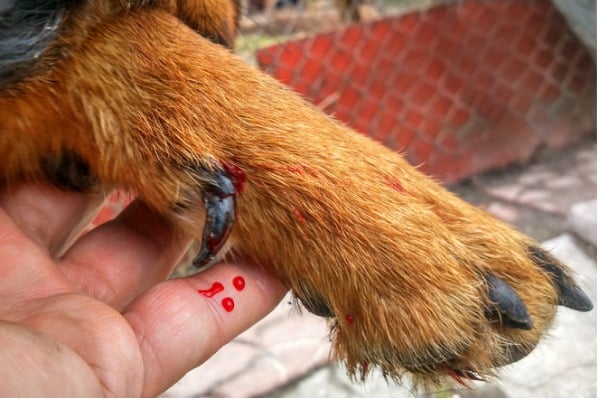
If there’s continuous bleeding, a clean towel or washcloth may be applied with gentle pressure.
Minor wounds will stop bleeding quickly, while deeper ones can take longer.
Bleeding should stop or significantly slow down within five minutes.
A vet should treat a wound that has not slowed to a stop within ten minutes.
5. Disinfect the Wound
Betadine is a good product to keep on hand for cuts and abrasions, including on your dog’s paw.
However:
If you don’t have any, antibacterial soap is sufficient for disinfecting a paw cut.
When using soap, be sure to rinse the suds with water thoroughly.
You don’t want the wash to be hot, as it can cause unnecessary pain for your dog. Lukewarm water is fine.
Very gently pat the area dry. Avoid wiping and rubbing, which can open the wound further.
6. Cover the Wound
Whether you have a dog first aid kit or one made for humans, you probably have everything you need to bandage the wound.
Vet wrap is useful and durable, but the gauze wrap found in your first aid kit is also helpful for bandaging a dog’s paw.
Place gauze pads on the wound before wrapping it.
This makes things more comfortable for your dog and also provides an absorbent layer for any residual bleeding.
It can take a few tries to get the wrap not too loose but not too tight.
Too loose, and it’ll fall right off. Too tight, and it can cause circulation issues for your dog.
A good guideline: make sure you can fit two fingers between the wrap and your dog’s paw.
Wrapping your dog’s entire paw is the best practice.
Extending it up to the ankle area will help keep it from slipping off.
Your dog won’t be too keen on walking on the wrapped paw right away but don’t worry.
The area is still tender, and the bandage will feel strange to them.
Monitor them closely or keep the cone on them if they attempt to tear the bandage off.
If your dog has a set of booties, pop one on over the bandaging for an extra barrier against the elements.
7. Change the Bandage
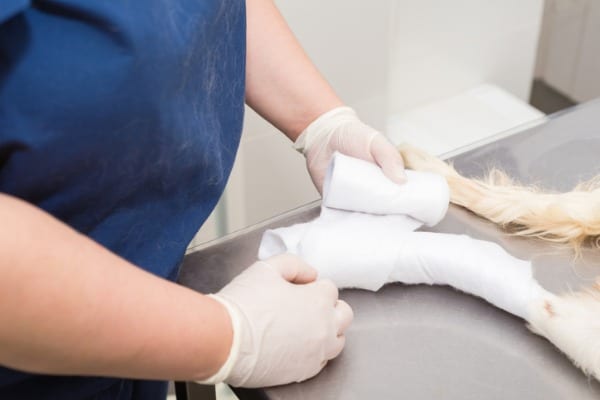
Changing the wrap every 24 hours will keep things clean and also give you a chance to check on the wound.
It should start to heal and show signs of closing within three days – if not, a vet should take a look.
There might be minor bleeding when you remove the bandage or traces of blood on the gauze pads.
This is no cause for alarm as long as it doesn’t last beyond three days.
Also:
Look for swelling, pus, or redness between their toes – all are signs of infection that should be reported to your vet.
8. Keep Your Dog Still
At least keep them as still as you can.
Running, playing, and bouncing around will stunt the healing process and can re-open wounds.
It’s best to have a couple of quiet days inside to allow the cut to heal.
Allow your dog to go outside to potty, of course – but long walks, fetch, and roughhousing will have to wait.
Dog Paw Cut Between Toes: Old Cuts?
How to heal dog paws when you don’t notice the wound right away?
A dog paw wound that isn’t fresh can be handled similarly to a fresh wound.
If you don’t notice a wound on your dog’s paw right away, odds are it’s not too severe.
There are some cases when your dog might have wandered off or gotten lost, and could have sustained a nasty injury even if they aren’t actively bleeding.
In scenarios such as those, your dog should go to the vet either way.
Otherwise, follow steps similar to those necessary for fresh wounds.
1. Wash the Area
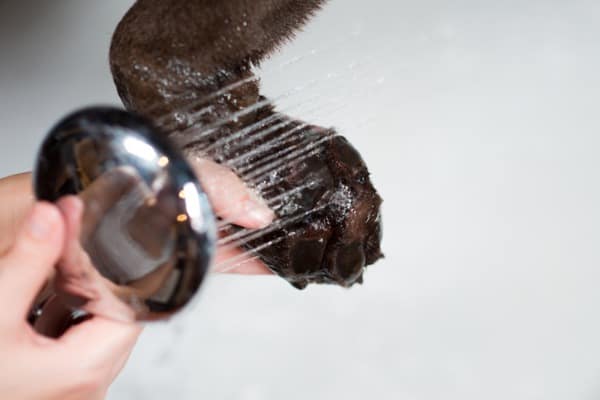
Sometimes a dog doesn’t show signs of a cut or bleed enough that you notice anything is wrong until much later.
If your dog’s foot pads are cut but not bleeding, or you find congealed blood on their paw, it’s still a good idea to wash it off and inspect it for lodged objects.
2. Remove Small Objects – Save Large Ones for the Vet to Handle
The same rules apply to foreign objects – large, deeply embedded ones should be removed by the vet.
Tweezers should be all you need to remove anything from your dog’s paw or between their toes.
Don’t go digging around:
If it’s stuck that badly, the vet should take care of it.
3. Clean the Wound
Washing with cool to lukewarm water and soap or betadine is a must.
Wounds that have gone unnoticed have a higher chance of becoming infected.
4. Wrap the Wound
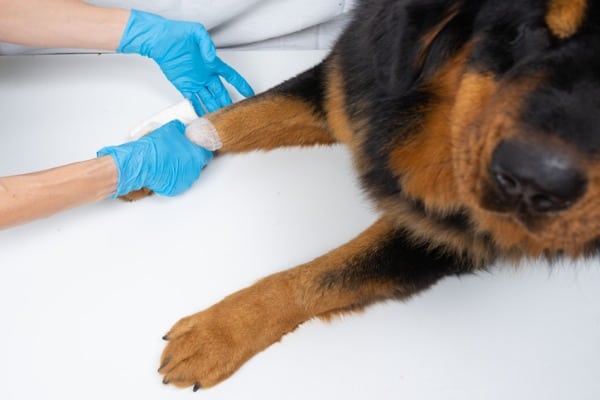
Even if the wound isn’t bleeding, covering it the same way you’d cover a fresh wound is a wise idea.
It’ll make it easier for your dog to walk and protect the area as it heals.
5. Watch Out for Infection
Change the bandage every 24 hours and look for signs it has become infected.
Pus, swelling, and increased redness are signs of infection. Additionally, a red bump on your dog’s paw is another sign to look out for.
The area might also feel hot, and your dog could show signs of discomfort or pain when you handle their paw.
A continued limp that doesn’t show improvement within three days is another sign your dog’s wound isn’t healing properly.
Preventing Cuts
A cut on a dog’s paw is usually easy to treat, but it’s still better to avoid it if you can.
The easiest safety measure is putting booties on your dog any time you go somewhere you’re not 100% sure is safe.
Beaches, swimming holes, and hiking trails are examples of where broken glass and sharp rocks can lurk.
Although:
Any public place carries the risk of debris that can cut your dog’s paws.
Durable booties for your dog provide a tough barrier between sharp things and those beloved feet.
Getting your dog used to them can take some time, but it’s easier than dealing with paw wounds.
Another good preventive tool is training your dog to have a good recall.
Why is this so important?
Dogs don’t always pay attention to their surroundings. While enjoying outdoor adventures, you might notice danger before your dog does.
So, if you see your dog barreling straight towards a pile of scrap metal, it’s vital that they listen when you tell them to return to you.
A strong recall can help protect your dog from a variety of dangerous scenarios, so we encourage working on this aspect of training.
Paw First Aid
Some of the most common paw injuries are those that you can take care of at home.
This includes anything from cuts to your dog’s paw showing signs of peeling.
If you don’t already have one, a dog first-aid kit is very helpful if you ever find yourself treating a cut on your dog’s foot.
When your dog’s foot pads are cut, they can be a little dramatic – but who can blame them?
Most of us know the uncomfortable feeling of a cut foot, so don’t panic if your dog acts like it’s the end of the world.
The crucial things to assess are bleeding, large foreign objects, and infection.
Remember:
Bleeding that hasn’t stopped in ten minutes is a reason to head straight to the vet.
Also:
Don’t go digging for objects which have gotten deep into your dog’s paw – it could make the wound worse and cause everyone added stress and putting your dog’s health at higher risk.
Otherwise, the first aid you give your dog for minor cuts is often all that’s needed – and maybe a few kisses on the paw to make them feel better.

